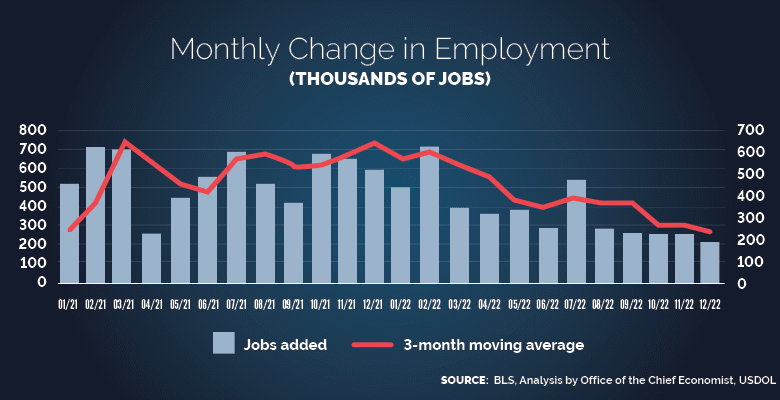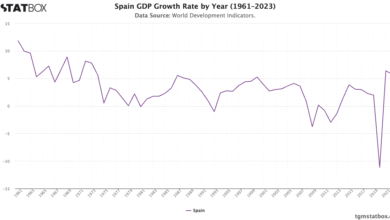Jobs Report Insights: Economic Direction Revealed

The upcoming jobs report, set to be released by the Labor Department, promises to offer crucial insights into the current state of the U.S. economy. Economists predict an increase of 133,000 in nonfarm payrolls, marking a notable decrease from March’s robust gain of 228,000. While this anticipated figure would remain close to the first quarter’s average of 152,000, any deviation below expectations could heighten concerns about economic stability amid recent negative indicators. The April jobs report is especially significant as it emerges alongside rising unemployment claims and a decrease in job openings, painting a complex picture of job growth and employment data. As investors eagerly await this vital economic report, the implications for market sentiment and future job growth forecasts could be substantial, making this Friday’s release a pivotal moment for understanding the direction of the economy.
This week’s labor statistics are poised to shine a spotlight on the evolving employment landscape in the United States. Analysts and economists alike will be keenly examining this employment report, which is crucial for evaluating job creation trends and overall economic health. With a potential rise in nonfarm payroll numbers to scrutinize, the significance of labor market dynamics is underscored, particularly in light of fluctuating economic indicators and concerns over employment conditions. The effects of policy changes, such as tariffs imposed by the current administration, may also influence job growth and the stability of various sectors. Overall, the release of the latest employment data will serve as an essential resource for gauging economic conditions and forecasting future labor market trends.
Understanding the April Jobs Report and Its Implications
The April jobs report is poised to be a critical piece of economic data for investors and policymakers. With expectations set for the addition of 133,000 jobs in nonfarm payrolls, analysts are gauging the implications of this figure against past performance. The significant dip from March’s robust gain of 228,000 raises questions about the underlying health of the job market, especially in the context of ongoing concerns surrounding economic indicators such as wage growth and employment levels. Economists will analyze the report closely to discern whether the current trends indicate a transient downturn or a more pronounced shift in the labor market.
This upcoming report is particularly important as it follows a string of negative economic signals, including lower job openings and rising unemployment claims. If the report falls short of expectations, it could reinforce fears of a weakening economy impacted by external factors, such as tariffs and government layoffs. The data released could either stabilize or shake investor confidence as Wall Street navigates the complexities of these economic indicators, marking the April jobs report as a key determinant of future market projections.
The Role of Nonfarm Payrolls in Economic Analysis
Nonfarm payrolls serve as a pivotal metric in assessing the overall employment landscape in the United States. By measuring the number of jobs added or lost in various sectors, this indicator offers invaluable insights into economic health and job growth forecasts. A forecasted increase of 133,000 jobs, while indicating positive growth, is notably lower than the figures observed in previous months. Analysts use this data not only to interpret current economic conditions but also to inform discussions about monetary policy and inflation rates.
Moreover, the significance of nonfarm payrolls extends beyond mere job counts; they reflect the pulse of the economy, indicating sectors that are thriving and those facing challenges. A detailed analysis of these trends enables economists to predict future employment data and gauge overall economic resilience. As the April jobs report approaches, market participants are keenly focused on these numbers, which can considerably influence stock market directions and economic sentiment.
Key Economic Indicators to Watch
In addition to nonfarm payrolls, several economic indicators will accompany the April jobs report that could shape market reactions. Metrics such as average hourly earnings are essential for understanding wage trends, which directly impact consumer spending power and inflationary pressures. A forecasted rise of 0.3% in hourly earnings is a critical statistic that investors will consider, as it suggests stability in wage growth amidst fluctuating employment numbers.
Other indicators, such as the unemployment rate and job vacancy levels, provide context for the labor market’s health. With unemployment claims on the rise and job openings experiencing significant drops, the overall employment landscape appears to be under strain. The interplay between these figures and the core nonfarm payroll results will be instrumental in drawing conclusions about the broader economic environment following the release of the jobs report.
Job Growth Forecasts Amid Economic Volatility
In light of prevailing economic conditions, job growth forecasts reflect a cautious but hopeful approach towards employment recovery. Economists are predicting modest job gains of approximately 105,000 to maintain the unemployment rate around 4.2%. While this figure may not signify robust growth, it highlights the potential for stability in a turbulent economic climate. Understanding these forecasts in relation to previous employment data will be critical for interpreting the April jobs report.
The anticipated job growth, albeit lower than desired, may still indicate resilience within specific sectors that can withstand external pressures, such as tariffs and policy uncertainty. However, analysts warn that a disappointing report showing figures below 100,000 could shift market sentiment negatively, causing investors to reassess their strategies in response to slower growth trajectories. The upcoming report will thus serve not only as a reflection of current job metrics but also as a lens into future economic directions.
The Significance of Employment Data for Investors
Employment data, particularly upcoming labor statistics, hold substantial weight for investors looking to gauge the economic landscape. The release of the April jobs report will be closely monitored by market participants as it provides insights into consumer confidence and spending habits. Since robust job numbers typically correlate with increased spending, a positive report could bolster investor sentiment, while a lower-than-expected figure might result in market volatility due to heightened uncertainty.
Furthermore, the interrelationships between employment data, inflation, and monetary policy decisions by the Federal Reserve are fundamental to market analysis. Investors are also keenly aware of how employment figures affect the Fed’s approach to interest rates, which has broader implications for investment strategies. Thus, the April jobs report will be a critical event, shaping not only immediate market reactions but also long-term economic expectations.
Inflation Concerns and Wage Growth Trends
As the April jobs report approaches, inflation concerns are at the forefront of economic discussions. Wage growth trends will be scrutinized as they play a significant role in determining inflationary pressures within the economy. If the forecasted growth of 0.3% in average hourly earnings materializes, it could suggest a healthy wage environment, which might alleviate some fears regarding rising costs and spur consumer spending.
Conversely, stagnant wage growth amid a decline in job openings could indicate underlying problems within the job market, raising questions about the sustainability of consumer confidence. Investors and economic analysts alike will be dissecting these nuances in the forthcoming report, understanding that wage data not only influences current economic health but also future monetary policy decisions.
Analyzing Job Satisfaction in Today’s Market
Job satisfaction metrics reveal much about the current state of the labor market, with the latest reports suggesting a decline in worker happiness. According to recent data, wage satisfaction has plummeted to its lowest since November 2021, signifying potential discontent among employees as they navigate economic uncertainties. This decline in satisfaction could affect productivity and retention rates, posing additional challenges for businesses trying to maintain a steady workforce.
Understanding the implications of job satisfaction trends is essential for economic stakeholders, as workforce morale can significantly influence overall economic growth. As the April jobs report unfolds, insights into worker contentment levels, especially among recent graduates facing rising unemployment rates, will be critical. A deeper look into these sentiments may offer predictive value regarding future labor market developments and economic strategies.
The Impact of Tariffs on Job Growth
The implementation of tariffs under the Trump administration has raised concerns regarding job growth forecasts and the overall economic landscape. These tariffs, meant to protect American industries, have induced uncertainty, affecting hiring practices across sectors. As businesses navigate the complexities of increased costs and trade negotiations, job creation has seen varying responses, casting a shadow on the overall employment outlook highlighted in the upcoming jobs report.
Given that many employers are hesitant to expand their workforce amid escalating trade tensions, the April jobs report will be pivotal in assessing the damage of these policies. Analysts will look for evidence of job growth resilience or the pervasive impacts of tariffs leading to stagnated employment figures. The correlation between tariffs, economic anxiety, and labor market trends will likely shape investor responses and policy discussions in the weeks following the report.
Preparing for Market Reactions Post-Jobs Report
With the April jobs report set to release soon, markets anticipate significant reactions that could reverberate through various sectors. Traders and investors are preparing for potential volatility, especially if the results diverge from expectations. As indicated by economist Mark Zandi, a number below 100,000 could trigger caution and re-evaluation of investment strategies as financial markets digest the implications of such disappointing news.
In scenarios where job growth meets or exceeds forecasts, markets are likely to react positively, reinforcing confidence in economic recovery. The broad spectrum of employment data, from job numbers to wage growth, shapes not only individual sectors but the economy as a whole. Thus, investors are ready to adapt, knowing that market dynamics hinge largely on the insights provided by the upcoming jobs report.
Frequently Asked Questions
What are the key projections from the April jobs report regarding nonfarm payrolls?
The April jobs report is projected to show an increase in nonfarm payrolls of 133,000, a decline from the 228,000 increase reported in March. While this represents a significant drop, it remains close to the average of 152,000 for the first quarter, which analysts hope will stabilize the unemployment rate around 4.2%.
How do economists view the potential impact of the upcoming April jobs report on economic indicators?
Economists are anticipating that the April jobs report will provide critical insights into economic indicators amidst concerns over tariffs and mixed data trends. A strong report with payroll growth nearer to 150,000 could ease market fears, while a disappointing figure under 100,000 could lead to increased caution among investors.
What recent trends could affect job growth forecasts in the April jobs report?
Recent trends, such as a contraction in GDP and rising unemployment claims, could weigh heavily on job growth forecasts for the April jobs report. Additionally, a drop in job openings and disappointing private payroll sectors have raised concerns about the overall employment landscape.
What significance does the unemployment rate hold in the context of the April jobs report?
In the context of the April jobs report, maintaining the unemployment rate around 4.2% is crucial. A well-performing jobs report with solid payroll growth could help sustain this rate, while a significant downturn in payrolls could indicate deteriorating employment conditions.
How might the April jobs report influence the perception of wage growth?
The April jobs report is expected to include wage data that will be closely monitored for signs of inflation control. Analysts anticipate an average hourly earnings increase of 0.3%, which, if realized, would suggest a year-over-year wage growth of approximately 3.9%, indicating a potential stabilization in wage growth amidst current economic uncertainties.
What was the trend in job dissatisfaction noted ahead of the April jobs report?
Ahead of the April jobs report, a significant trend in job dissatisfaction was noted, with wage satisfaction falling to 54.8%, the lowest since November 2021. This decline reflects growing employee concerns about job security and compensation, which could be relevant to the report’s insights on nonfarm payrolls.
How do financial markets usually react to the April jobs report, especially with recent economic data?
Financial markets typically react sensitively to the April jobs report, especially given the backdrop of recent disappointing economic data. If the report meets or exceeds expectations, it may bolster investor confidence; however, a poor report could lead to a negative shift in market sentiment, prompting caution among traders.
| Key Point | Details |
|---|---|
| Expected Nonfarm Payroll Increase | 133,000, down from 228,000 in March, but close to the 152,000 average for Q1. |
| Concerns Over Economic Sentiment | A miss below 100,000 could indicate negative sentiment and tougher market conditions. |
| GDP Contraction | 0.3% contraction in Q1, raising concerns about economic stability. |
| Weak Employment Indicators | Job openings fell to 7.2 million; unemployment claims increased. |
| Worker Dissatisfaction | Wage satisfaction at 54.8%, average reservation wage dropped to $74,236. |
| Federal Layoffs | 281,452 federal layoffs announced; total could be up to 1.2 million. |
Summary
The upcoming jobs report is crucial for understanding the current state and future trajectory of the economy. With economists forecasting a significant drop in nonfarm payroll growth, from the previously strong figures seen in March, concerns are mounting over the overall economic sentiment. The interplay of recent GDP contraction, weak employment numbers, and high levels of dissatisfaction among workers signal underlying challenges that could affect market stability. The April jobs report will be closely watched for indications of whether the economy is merely experiencing temporary setbacks or if deeper issues are at play. Investors and policy makers will need to tread carefully in the wake of these indicators.



